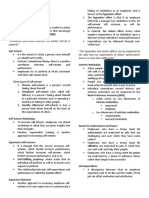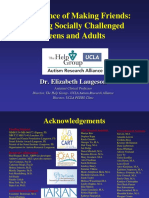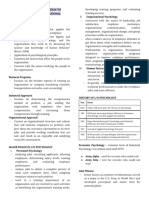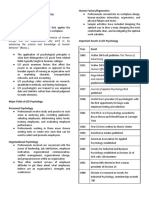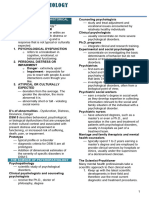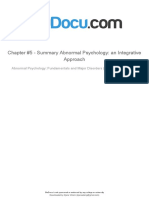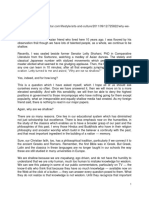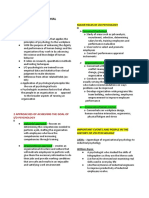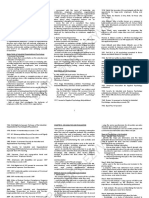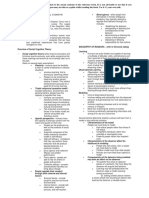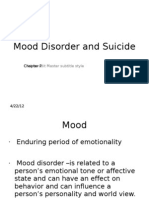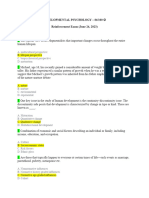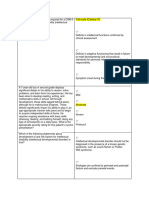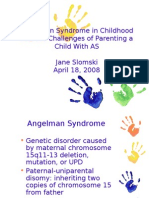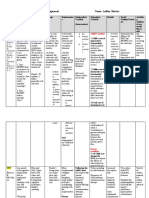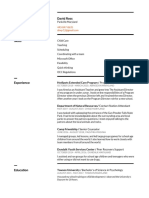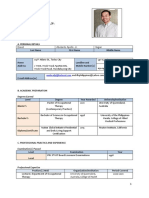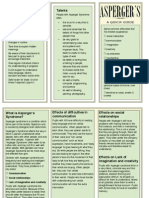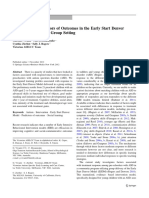C) Full-Scale IQ Below 70. C) Major Neurocognitive Disorder Due To Traumatic Brain Injury
C) Full-Scale IQ Below 70. C) Major Neurocognitive Disorder Due To Traumatic Brain Injury
Uploaded by
ErikaCopyright:
Available Formats
C) Full-Scale IQ Below 70. C) Major Neurocognitive Disorder Due To Traumatic Brain Injury
C) Full-Scale IQ Below 70. C) Major Neurocognitive Disorder Due To Traumatic Brain Injury
Uploaded by
ErikaOriginal Title
Copyright
Available Formats
Share this document
Did you find this document useful?
Is this content inappropriate?
Copyright:
Available Formats
C) Full-Scale IQ Below 70. C) Major Neurocognitive Disorder Due To Traumatic Brain Injury
C) Full-Scale IQ Below 70. C) Major Neurocognitive Disorder Due To Traumatic Brain Injury
Uploaded by
ErikaCopyright:
Available Formats
Abnormal Psychology Pre-Test adaptive functioning such that he
requires support in some areas of
1. Which of the following is not functioning. He is also displaying
required for a DSM-5 diagnosis of anxious and depressive symptoms
intellectual disability(intellectual in response to his accident and
developmental disorder)? * hospitalization. What is the least
likely diagnosis? *
a) Deficits in intellectual
functions confirmed by clinical
assessment. a) Specific learning disorder
b) Symptom onset during the b) Traumatic brain injury.
developmental period. c) Major neurocognitive disorder
c) Full-scale IQ below 70. due to traumatic brain injury.
d) Deficits in adaptive functioning d) Intellectual disability
that result in failure to meet (intellectual developmental
developmental and disorder).
sociocultural standards for
personal independence and 4. A 25-year-old man presents with
social responsibility. long-standing nonverbal
communication deficits, inability to
2. Which of the following statements
have a back-and-forth conversation
about the diagnosis of intellectual or share interests in an appropriate
disability(intellectual
fashion, and a complete lack of
developmental disorder) is false? * interest in having relationships with
others. His speech reflects
a) Adaptive functioning must take
awkward phrasing and intonation
into account the three
and is mechanical in nature. He
domains of conceptual, social,
has a history of sequential fixations
and practical functioning.
and obsessions with various
b) An individual with an IQ above
games and objects throughout
75 would not meet diagnostic
childhood; however, this is not
criteria even if there were
currently a major issue for him.
impairments in adaptive
This patient meets criteria for
functioning.
autism spectrum disorder; true or
c) In forensic assessment,
false? *
severe deficits in adaptive
functioning might allow for a
diagnosis with an IQ above a) False
75. b) True
d) The specifiers mild, moderate,
severe, and profound are
based on IQ scores. 5. A 30-year-old single woman
reports having experienced
3. A 10-year-old boy with a history of auditory and persecutory delusions
dyslexia, who is otherwise for 2 months, followed by a full
developmentally normal, is in a major depressive episode with sad
skateboarding accident in which he mood, anhedonia, and suicidal
experiences severe traumatic brain ideation lasting 3 months. Although
injury. This results in significant the depressive episode resolves
global intellectual impairment(with with pharmacotherapy and
a persistent reading deficit that is psychotherapy,the psychotic
more pronounced than his other symptoms persist for another
newly acquired but stable deficits, month before resolving. What
along with a full-scale IQ of 75). diagnosis best fits this clinical
There is mild impairment in his picture? *
a) Brief psychotic disorder. talkative than usual and is easily
b) Schizoaffective disorder. distractible, to the point of finding it
c) Major depressive disorder with difficult to complete his work
psychotic features. assignments. A physical
d) Major depressive disorder. examination and laboratory workup
are negative for any medical cause
of his symptoms and he takes no
6. A 55-year-old man with a known
history of alcohol dependence and medications. What diagnosis best
fits this clinical picture? *
schizophrenia is brought to the
emergency department because of
frank delusions and visual a) Hypomanic episode.
hallucinations. Which of the b) Bipolar I disorder, with mixed
following would not be a diagnostic features.
possibility for inclusion in the c) Manic episode.
differential diagnosis? * d) Major depressive episode.
a) Alcohol dependence. 9. A patient with a history of bipolar
b) Borderline personality disorder disorder reports experiencing 1
with psychotic features. week of elevated and expansive
c) Substance/medication-induced mood. Evidence of which of the
psychotic disorder. following would suggest that the
d) Schizophrenia. patient is experiencing a
hypomanic, rather than manic,
7. A 19-year-old college student is episode? *
brought by ambulance to the
emergency department. His a) Increased productivity at work.
college dorm supervisor, who b) Irritability.
called the ambulance, reports that c) Psychotic symptoms.
the student was isolating himself, d) Decreased need for sleep.
was pacing in his room, and was
not responding to questions. In the
emergency department, the patient 10. A 12-year-old boy begins to have
gets down in a crouching position new episodes of temper outbursts
and begins making barking noises that are out of proportion to the
at seemingly random times. His situation. Which of the following is
urine toxicology report is negative, not a diagnostic possibility for this
and all labs are within normal patient? *
limits. What is the best description
of these symptoms? * a) Disruptive mood dysregulation
disorder.
a) Intermittent explosive rage. b) Oppositional defiant disorder.
b) Catatonic behavior. c) Conduct disorder.
c) A paranoid stance leading to d) Bipolar disorder.
self-protective aggression.
d) An animal delusion—the 11. Children with disruptive mood
patient believes he is a dog. dysregulation disorder (DMDD)
often meet criteria for what
8. A 32-year-old man reports 1 week additional DSM-5 diagnosis? *
of feeling unusually irritable. During
this time, he has increased energy a) Intermittent explosive disorder.
and activity, sleeps less, and finds b) Schizophrenia.
it difficult to sit still. He also is more c) Pediatric bipolar disorder.
d) Oppositional defiant disorder. a) Dysmenorrhea.
b) Premenstrual dysphoric
disorder.
12. A 9-year-old boy is brought in for
evaluation because of explosive c) Factitious disorder.
d) Premenstrual syndrome.
outbursts when he is frustrated
with schoolwork. The parents
report that their son is well 15. Which of the following disorders is
behaved and pleasant at other included in the “Anxiety Disorders”
times. Which diagnosis best fits chapter of DSM-5? *
this clinical picture? *
a) Separation anxiety disorder.
a) Major depressive disorder. b) Posttraumatic stress disorder.
b) Disruptive mood dysregulation c) Acute stress disorder.
disorder. d) Panic disorder with
c) Intermittent explosive disorder. agoraphobia.
d) Pediatric bipolar disorder.
16. A 50-year-old man reports
13. A 14-year-old boy describes episodes in which he suddenly and
himself as feeling “down” all of the unexpectedly awakens from sleep
time for the past year. He feeling a surge of intense fear that
remembers feeling better while he peaks within minutes. During this
was at camp for 4 weeks during time, he feels short of breath and
the summer; however, the has heart palpitations, sweating,
depressed mood returned when he and nausea. His medical history is
came home. He reports poor significant only for hypertension,
concentration, feelings of which is well controlled with
hopelessness, and low self-esteem hydrochlorothiazide. As a result of
but denies suicidal ideation or these symptoms, he has begun to
changes in his appetite or sleep. have anticipatory anxiety
What is the most likely associated with going to sleep.
diagnosis? * What is the most likely explanation
for his symptoms? *
a) Disruptive mood dysregulation
disorder. a) Substance/medication-induced
b) Depressive episodes with anxiety disorder.
short-duration hypomania. b) Sleep terrors.
c) Major depressive disorder. c) Anxiety disorder due to
d) Persistent depressive disorder another medical condition
(dysthymia), with early onset. (hypertension).
d) Panic disorder.
14. A 29-year-old woman complains of
a sad mood every month in 17. A 65-year-old woman reports being
anticipation of her very painful housebound despite feeling
menses. The pain begins with the physically healthy. Several years
start of her flow and continues for ago, she fell while shopping;
several days. She does not although she sustained no injuries,
experience pain during other times the situation was so upsetting that
of the month. She has tried a she became extremely nervous
variety of treatments, none of when she had to leave her house
which have given her relief. What unaccompanied. Because she has
is the appropriate diagnosis? * no children and few friends whom
she can ask to accompany her,
she is very distressed that she has 20. What is the most common site of
few opportunities to venture hair pulling in trichotillomania? *
outside her home. What is the
most likely diagnosis? *
a) Axillary area.
b) Facial area.
a) Agoraphobia c) Pubic area.
b) Post traumatic stress disorder. d) Scalp.
c) Social anxiety disorder (social
phobia). 21. A 6-year-old girl has repeatedly
d) Specific phobia, situational approached strangers while in the
type. park with her class. The teacher
requests an evaluation of the
18. Social anxiety disorder (social behavior. The girl has a history of
phobia) differs from normative being placed in several different
shyness in that the disorder leads foster homes over the past 3
to which of the following? * years. Which diagnosis is
suggested from this history? *
a) Social or occupational
dysfunction. a) Disinhibited social
b) Marked social reticence. engagement disorder (DSED).
c) Avoidance of social situations. b) Bipolar I disorder.
d) Derealization or c) Attention-deficit/hyperactivity
depersonalization. disorder (ADHD).
d) Autism spectrum disorder
19. A 25-year-old man is concerned (ASD).
that he looks “weak” and “puny”
despite the fact that to neutral 22. A 5-year-old child was present
observers he appears very when her babysitter was sexually
muscular. When confronted about assaulted. Which of the following
his belief he believes he is being symptoms would be most
humored and that people are in suggestive of post traumatic stress
fact making fun of his small size disorder (PTSD) in this child? *
behind his back. He has tried a
number of strategies to increase
muscle mass, including exercising a) Having dreams about
excessively and using anabolic princesses and castles.
steroids; however, he remains b) Expressing no fear when
dissatisfied with his appearance. talking about the event.
What is the most likely c) Playing normally with toys.
diagnosis? * d) Taking the clothing off her
dolls while playing.
a) Body identity integrity 23. A 3-year-old boy has rather severe
disorder. temper tantrums that have
b) Delusional disorder, somatic occurred at least weekly for a 6-
type. week period. Although the
c) Body dysmorphic disorder, tantrums can sometimes be
with muscle dysmorphia. associated with defiant behavior,
d) Narcissistic personality they often result from a change in
disorder. routine, fatigue, or hunger, and he
only rarely does anything
destructive. He is generally well
behaved in nursery school and psychotic symptoms. What is the
during periods between his most likely diagnosis? *
tantrums. Which of the following
conclusions best fits this child’s
presentation? * a) Oppositional defiant disorder
(ODD).
b) Conduct disorder.
a) The boy meets criteria for c) Major depressive disorder.
ODD because of the presence d) Attention-deficit/hyperactivity
of tantrums and defiant disorder (ADHD).
behavior.
b) The boy’s symptoms more 26. A 15-year-old boy has a history of
likely represent intermittent episodic violent behavior that is out
explosive disorder than ODD. of proportion to the precipitant.
c) The boy does not meet criteria During a typical episode, which will
for oppositional defiant escalate rapidly, he will become
disorder (ODD). extremely angry, punching holes in
d) The boy could be diagnosed walls or destroying furniture in the
with ODD as long as it does home. There seems to be no
not appear that his home specific purpose or gain associated
environment is harsh, with the outbursts, and within 30
neglectful, or inconsistent. minutes he is calm and “back to
himself,” a state that is not
24. A previously well-behaved 13-year- associated with any predominant
old girl begins to display extremely mood disturbance. What diagnosis
defiant and oppositional behavior, best fits this clinical picture? *
with vindictiveness. She is angry,
argumentative, and refuses to
accept responsibility for her a) Bipolar disorder.
behavior, which is affecting both b) Conduct disorder.
her home life and school life in a c) Disruptive mood dysregulation
significant way. What is the least disorder (DMDD).
likely diagnosis? * d) Intermittent explosive disorder
(IED).
a) Adjustment disorder. 27. A 15-year-old girl with a history of
b) Oppositional defiant disorder. cruelty to animals, stealing, school
c) Bipolar disorder. truancy, and running away from
d) Major depressive disorder. home shows no remorse when
caught, or when she is confronted
25. A 16-year-old boy with a long with how her behavior is affecting
history of defiant behavior toward the rest of her family. She
authority figures also has a history disregards the feelings of others
of aggression toward peers (gets and seems to not care that her
into fights at school),toward his conduct is compromising her
parents, and toward objects school performance. The behavior
(punching holes in walls, breaking has been present for over a year
doors). He frequently lies, and he and in multiple relationships and
has recently begun to steal settings. Which of the following
merchandise from stores and components of the “With limited
money and jewelry from his prosocial emotions” specifier is
parents. He does not seem absent in this clinical picture? *
pervasively irritable or depressed,
and he has no sleep disturbance or
a) Lack of concern about 30. In a patient with mild
performance. neurocognitive disorder (NCD),
b) Callous—lack of empathy. which of the following would
c) Shallow or deficient affect. distinguish probable from possible
d) Lack of remorse or guilt. Alzheimer’s disease? *
28. A 27-year-old woman presents for a) No evidence of mixed etiology.
psychiatric evaluation after almost b) Steadily progressive, gradual
hitting someone with her car while decline in cognition, without
driving under the influence of extended plateaus.
marijuana. She reports that she c) Clear evidence of decline in
was prompted to seek treatment by memory and learning.
her husband, with whom she has d) Evidence of a causative
had several conflicts over the past Alzheimer’s disease genetic
year about her ongoing marijuana mutation from either genetic
use. She has continued to smoke testing or family history.
two joints daily and drive while
under the influence of marijuana
since this event. What is the 31. A 68-year-old semiretired
appropriate diagnosis? * cardiologist with responsibility for
electrocardiogram(ECG)
interpretation at his community
a) Cannabis dependence. hospital is referred by the
b) Cannabis intoxication. hospital’s Employee Assistance
c) Cannabis use disorder. Program for clinical evaluation
d) Cannabis abuse. because of concerns expressed by
other clinicians that he has been
making many mistakes in his ECG
29. A 79-year-old woman with a history
of depression is being evaluated at interpretations over the past few
months. The patient discloses
a nursing home for a suspected
urinary tract infection. She is easily symptoms of persistent sadness
since the death of his wife 6
distracted, perseverates on
answers to questions, asks the months prior to the evaluation, with
frequent thoughts of death, trouble
same question repeatedly, is
unable to focus, and cannot sleeping, and escalating usage of
sedative-hypnotics and alcohol. He
answer questions regarding
orientation. The mental status has some trouble concentrating,
but he has been able to maintain
changes evolved over a single day.
Her family reports that they thought his household, pay his bills, shop,
and prepare meals by himself
she “wasn’t herself” when they saw
her the previous evening, but the without difficulty. He scores 28/30
on the Mini-Mental State
nursing report this morning
indicates that the patient was Examination(MMSE). Which of the
following would be the primary
cordial and appropriate. What is
the most likely diagnosis? * consideration in the differential
diagnosis? *
a) Major depressive disorder,
with anxious distress. a) Major neurocognitive disorder
(NCD).
b) Delirium.
c) Major depressive disorder, b) Major depressive disorder.
c) Mild NCD.
recurrent episode.
d) Depressive disorder due to d) Adjustment disorder.
another medical condition.
32. Both major and mild a) Narcissistic personality
neurocognitive disorders can disorder.
increase the risk of delirium and b) Avoidant personality disorder.
complicate its course. Traditionally, c) Obsessive-compulsive
delirium is distinguished from personality disorder.
dementia on the basis of the key d) Schizoid personality disorder.
features of acute onset,
impairment in attention, and which 35. A cardiologist requests a
of the following? * psychiatric consultation for her
patient, a 46-year-oldman,
a) Fluctuating course. because even though he is
b) Steady course. adherent to treatment, she is
c) Presence of mania. concerned that he “seems crazy.”
d) Presence of depression. On evaluation, the patient makes
poor eye contact, tends to ramble,
and makes unusual word choices.
33. Individuals with obsessive- He is modestly disheveled and
compulsive personality disorder wears clothes with mismatched
are primarily motivated by a need colors. He expresses odd beliefs
for which of the following? * about supernatural phenomena,
but these beliefs do not seem to be
a) Intimacy. of delusional intensity. Collateral
b) Control. information from his sister elicits
c) Admiration. the observation that “He’s always
d) Efficiency. been like this—weird. He keeps to
himself, and likes it that way.”
Which of the following conditions
34. A 36-year-old woman is best explains this man’s odd
approached by her new boss, who behaviors and beliefs? *
has noticed that despite working
for her employer for many years,
she has not advanced beyond an a) Schizoid personality disorder.
entry level position. The boss b) Schizotypal personality
hears that she is a good employee disorder.
who works long hours. The woman c) Paranoid personality disorder.
explains that she has not asked for d) Delusional disorder.
a promotion because she knows
she’s not as good as other 36. In which of the following situations
employees and doesn’t think she would a diagnosis of global
deserves it. She explains her long developmental delay be
hours by saying that she is not inappropriate? *
very smart and has to check over
all her work, because she’s afraid
that people will laugh at her if she a) The patient is a child who is
makes any mistakes. On reviewing too young to fully manifest
her past evaluations, her boss specific symptoms or to
notes that there are only minor complete requisite
critiques and her overall assessments.
evaluations have been very b) The patient’s scores on
positive. Which of the following psychometric tests suggest
personality disorders would best intellectual disability
explain this woman’s lack of job (intellectual developmental
advancement? * disorder), but there is
insufficient information about
the patient’s adaptive b) Tourette’s Disorder
functional skills. c) Developmental Coordination
c) The patient, a 7-year-old boy, Disorder
has a full-scale IQ of 65 and d) None of the above
severe impairment in adaptive
functioning. 39. What law required the change of
d) The patient’s impaired the term Mental Retardation to
adaptive functioning suggests Intellectual Disability? *
intellectual developmental
disorder, but there is
insufficient information about a) Antidiscrimination Law of 2008
the level of cognitive b) Antidiscrimination Law of 2009
impairment measured by c) Rosa’s Law
standardized instruments. d) Rosie’s Law
37. A 10-year-old boy demonstrates 40. Which among the following was a
hand-flapping and finger flicking, diagnosis in DSM IV pertaining to a
and he repetitively flips coins and high functioning ASD? *
lines up his trucks. He tends to
“echo” the last several words of a
question posed to him before a) Autistic Disorder
answering, mixes up his pronouns b) Childhood Disintegrative
(refers to himself in the second Disorder
person), tends to repeat phrases in c) Rett’s Disorder
a perseverative fashion, and is d) Asperger Syndrome
quite fixated on routines related to
dress, eating, travel, and play. He 41. What is the counterpart of
spends hours in his garage playing Cyclothymia in Schizophrenia
with his father’s tools. What do Spectrum Disorders, that is
these behaviors represent? * currently a condition for further
study? *
a) Prototypical manifestations of
obsessive-compulsive a) Dysthymia
personality. b) Attenuated Psychosis
b) Symptoms of pediatric acute- Syndrome
onset neuropsychiatric c) Schizophrenia
syndrome (PANS). d) Schizotypal Personality
c) Restricted, repetitive patterns Disorder
of behaviors, interests, or
activities characteristic of
autism spectrum disorder. 42. How long should psychotic
d) Symptoms of obsessive- symptoms be manifested without
compulsive disorder. mood symptoms to rule out the
possibility of a Bipolar/ Depressive
Disorder with Psychotic features? *
38. A child is brought to your clinic
because of problems with gross
motor and fine motor functioning. a) 2 months
Which among the following b) 1 week
diagnosis would you most likely c) 1 month
consider? * d) 2 weeks
a) Tic Disorder 43. The parents of your depressed
client complains that their child
could no longer bathe nor eat by 47. For an adolescent who presents
himself. What negative symptom is with distractibility, which of the
experienced by your client? * following additional features would
suggest an association with bipolar
II disorder rather than attention-
a) Avolition deficit/hyperactivity disorder
b) Asociality (ADHD)? *
c) Alogia
d) Anhedonia
a) Complaints of racing thoughts.
b) A report of less need for sleep.
44. Your client exhibits Somatic
Delusion that he has brain cancer. c) Evidence that the symptoms
are episodic
He also reports visual and tactile
hallucinations of seeing ants d) Rapid speech noted on
examination.
collecting sand and feeling them
enter his ear towards the brain,
causing the malignancy. If these 48. Which among the following is an
symptoms have been present for a appropriate statement about the
month, which among the following difference of Manic Episodes and
is the appropriate diagnostic Hypomanic Episodes? *
impression in this case? *
a) Hypomanic Episodes
a) Delusional Disorder necessitates hospitalization.
b) Brief Psychotic Disorder b) Hypomanic Episodes should
c) Illness Anxiety Disorder last for at least 4 consecutive
d) Somatic Symptom Disorder days.
c) Manic Episodes does not
45. If a client has been exhibiting necessitate hospitalization.
d) Manic Episodes should last for
symptoms of bipolar disorders but
do not meet the criteria for a at least 4 consecutive days.
Bipolar Disorder, what alternative
diagnosis will most likely be given 49. A college student seen by a
to the client? * counseling psychologist stated that
he had cut almost all his classes
during the past two weeks, had
a) Cyclothymic Disorder experienced difficulty sleeping, and
b) Bipolar II felt like his academic situation was
c) Bipolar I hopeless. What diagnosis would
d) Dysthymia the psychologist most likely
consider? *
46. A patient with a history of bipolar
disorder reports experiencing 1
week of elevated and expansive a) Bipolar disorder
b) Dissociative disorder
mood. Evidence of which of the
following would suggest that the c) Major depressive disorder
d) Undifferentiated schizophrenia
patient is experiencing a
hypomanic, rather than manic,
episode? 50. A client reports that he was
prescribed Maoi’s by his
psychiatrist. Which among the
a) Irritability. following should be part of your
b) Decreased need for sleep. psychoeducation? *
c) Increased productivity at work.
d) Psychotic symptoms.
a) Drink plenty of fluids c) Avoid cheese and beer
b) Sleep early d) None of the above
You might also like
- IO Psych Drills 22 July 2023Document12 pagesIO Psych Drills 22 July 2023Charisse Elica LucasNo ratings yet
- 20 ĐỀ THI THỬ TỐT NGHIỆP THPT NĂM 2021 MÔN TIẾNG ANH BÁM SÁT VÀ PHÁT TRIỂN ĐỀ MINH HỌA CỦA BỘ GD&ĐT CÓ ĐÁP ÁNDocument161 pages20 ĐỀ THI THỬ TỐT NGHIỆP THPT NĂM 2021 MÔN TIẾNG ANH BÁM SÁT VÀ PHÁT TRIỂN ĐỀ MINH HỌA CỦA BỘ GD&ĐT CÓ ĐÁP ÁNPhung Thuy71% (7)
- Introduction To Theories of PersonalityDocument17 pagesIntroduction To Theories of PersonalityLmg FermilanNo ratings yet
- IO Reviewer Chapter 9Document4 pagesIO Reviewer Chapter 9luzille anne alertaNo ratings yet
- TOP KleinHorneyDocument3 pagesTOP KleinHorneyCamae Snyder GangcuangcoNo ratings yet
- 3B Laugeson - The Science of Making FriendsDocument47 pages3B Laugeson - The Science of Making Friendslucia estrellaNo ratings yet
- Peaceful Coexistance - Autism, Asperger's, HyperlexiaDocument4 pagesPeaceful Coexistance - Autism, Asperger's, HyperlexiaDefault User100% (1)
- I O-PsychologyDocument16 pagesI O-PsychologyHazel AnnNo ratings yet
- IO Reviewer Chapter 14Document3 pagesIO Reviewer Chapter 14luzille anne alertaNo ratings yet
- I/O Reviewer Chapter 1Document3 pagesI/O Reviewer Chapter 1luzille anne alertaNo ratings yet
- Ethical Considerations in Psychological AssessmentDocument5 pagesEthical Considerations in Psychological Assessmentjonacambri06No ratings yet
- Developmental Psychology ReviewerDocument5 pagesDevelopmental Psychology ReviewerKEANNA RUBIANo ratings yet
- Industrial Psy PDFDocument13 pagesIndustrial Psy PDFmiss perfectionistNo ratings yet
- Abpsych Reviewer FinalsDocument7 pagesAbpsych Reviewer FinalsHeidi BrionesNo ratings yet
- TOS Outline PsychAssess 2.0Document37 pagesTOS Outline PsychAssess 2.0vq5hdfxtmyNo ratings yet
- Chapter One Social Psychology David Myers 11eDocument8 pagesChapter One Social Psychology David Myers 11eAlyssa Mae NoveroNo ratings yet
- I/O Reviewer Chapter 12Document3 pagesI/O Reviewer Chapter 12luzille anne alerta100% (1)
- Social Psychology ReviewerDocument3 pagesSocial Psychology ReviewerAngelou CincoNo ratings yet
- Industrial Psychology Module 2022 ZANEDocument58 pagesIndustrial Psychology Module 2022 ZANEKeanna Mae DumaplinNo ratings yet
- Industrial/Organizational Psychology - Chapters 1 - 5Document13 pagesIndustrial/Organizational Psychology - Chapters 1 - 5Myca Katrina CantaneroNo ratings yet
- Psych Stats Intro To Psych StatsDocument7 pagesPsych Stats Intro To Psych Statscarmelalouis.trinidadNo ratings yet
- Abnormal Psychology ReviewerDocument23 pagesAbnormal Psychology ReviewerPinca, Junea PaulaNo ratings yet
- 30Document9 pages30Philip MercadoNo ratings yet
- PHYP211 PRELIMS - MergedDocument11 pagesPHYP211 PRELIMS - MergedSARAH MARGARETTE PAGLINAWANNo ratings yet
- Psychology ReviewerDocument4 pagesPsychology ReviewerArthur Bach100% (1)
- Devpsy PrelimsDocument17 pagesDevpsy PrelimsCarmina Villaruel100% (1)
- Summary Book Abnormal Psychology Barlow Durand PDFDocument58 pagesSummary Book Abnormal Psychology Barlow Durand PDFLee DonghyuckNo ratings yet
- ABPS311 - ReviewerDocument7 pagesABPS311 - ReviewerKiana De UngriaNo ratings yet
- Industrial Organizational Transes 1Document21 pagesIndustrial Organizational Transes 1delta bravo100% (1)
- Abnormal PsychologyDocument19 pagesAbnormal PsychologyRachelle BlancoNo ratings yet
- Blepp Plan: Know Thyself Ft. Problem Solving CycleDocument5 pagesBlepp Plan: Know Thyself Ft. Problem Solving CycleRoseNo ratings yet
- B. Diagnostic TestDocument28 pagesB. Diagnostic TestMARIA STEPHANY DELA CRUZNo ratings yet
- Chapter #5 - Summary Abnormal Psychology: An Integrative Approach Chapter #5 - Summary Abnormal Psychology: An Integrative ApproachDocument13 pagesChapter #5 - Summary Abnormal Psychology: An Integrative Approach Chapter #5 - Summary Abnormal Psychology: An Integrative ApproachDjane VillarinNo ratings yet
- Mental Images and PropositionsDocument25 pagesMental Images and Propositionsmylene davidNo ratings yet
- Why We Are Shallow - F Sionil JoseDocument3 pagesWhy We Are Shallow - F Sionil JoseBam DisimulacionNo ratings yet
- Project Aristotle: The Field of I/O PsychologyDocument8 pagesProject Aristotle: The Field of I/O PsychologyTin EupenaNo ratings yet
- I/Opsychologyaamodt I/Opsychologyaamodt: Psychology (De La Salle Lipa) Psychology (De La Salle Lipa)Document16 pagesI/Opsychologyaamodt I/Opsychologyaamodt: Psychology (De La Salle Lipa) Psychology (De La Salle Lipa)Liandra Marie CollanteNo ratings yet
- AbPsych Reviewer 1 PDFDocument8 pagesAbPsych Reviewer 1 PDFSyndell PalleNo ratings yet
- DSM5 - CerenoDocument20 pagesDSM5 - CerenoChelsea Glyce CerenoNo ratings yet
- IO Reviewer Chapter 13Document4 pagesIO Reviewer Chapter 13luzille anne alertaNo ratings yet
- IO Chapter 1-5 PDFDocument10 pagesIO Chapter 1-5 PDFJasmin ValloNo ratings yet
- The Referral Question - Purpose of Assessment by Setting or ContextDocument3 pagesThe Referral Question - Purpose of Assessment by Setting or ContextNancy Fernandez100% (1)
- Io-Psych Outline-ReviewDocument2 pagesIo-Psych Outline-ReviewfaizaNo ratings yet
- 1 IntroductionDocument27 pages1 IntroductionKEITH ASHLEY BATITISNo ratings yet
- DEVPSY Reviewer - Chapters 1-6Document19 pagesDEVPSY Reviewer - Chapters 1-6Hannah MondillaNo ratings yet
- Lerroc Exam 1Document12 pagesLerroc Exam 1John LouiseNo ratings yet
- AbPsych Reviewer 5Document11 pagesAbPsych Reviewer 5Syndell PalleNo ratings yet
- I-O Psy Lecture NotesDocument14 pagesI-O Psy Lecture NotesNoel DogmaNo ratings yet
- Term Paper in PsychologyDocument5 pagesTerm Paper in PsychologyBrenda Moore0% (1)
- Top - Ch17 (Bandura) ReviewerDocument6 pagesTop - Ch17 (Bandura) ReviewerJojit EspirituNo ratings yet
- Module 6 PSYCH ASSESS Intelligence and Its MeasurementDocument72 pagesModule 6 PSYCH ASSESS Intelligence and Its MeasurementJie Ann Faith AusmoloNo ratings yet
- Abnormal Psychology Summary (Chapter 3 - 4)Document15 pagesAbnormal Psychology Summary (Chapter 3 - 4)Louise Alenah LabragueNo ratings yet
- Dev Psych Chapter 1 NotesDocument5 pagesDev Psych Chapter 1 NotesJan Dela RosaNo ratings yet
- Characteristics of A Good Test: Content ValidityDocument23 pagesCharacteristics of A Good Test: Content ValidityAllan LariosaNo ratings yet
- Field Methods in PsychologyDocument19 pagesField Methods in PsychologyHanny OlasoNo ratings yet
- Abpsy Lecture Chapter 1.1 - 2Document4 pagesAbpsy Lecture Chapter 1.1 - 2Tracey GoldNo ratings yet
- ABNORMAL PSYCHOLOGY (Chapters 1-7)Document35 pagesABNORMAL PSYCHOLOGY (Chapters 1-7)Fiona Zoe AbellaNo ratings yet
- Mood Disorder and SuicideDocument62 pagesMood Disorder and Suicideirish x100% (1)
- Devpsych ReinforcementDocument19 pagesDevpsych ReinforcementDivine Menchu100% (1)
- Abnormal Psychology NotesDocument7 pagesAbnormal Psychology NotesDante Manansala Jr.100% (1)
- Quizlet Chapters 1-4 Abnormal PsychologyDocument7 pagesQuizlet Chapters 1-4 Abnormal PsychologyMyk Abaya0% (1)
- Assessment 4 (BE)Document9 pagesAssessment 4 (BE)Aryan Judith DoloresNo ratings yet
- Psychology Block 7 DiscussionDocument4 pagesPsychology Block 7 DiscussionErikaNo ratings yet
- Psychology Block 7 QuizDocument2 pagesPsychology Block 7 QuizErikaNo ratings yet
- Psychology Block 5 - BussDocument2 pagesPsychology Block 5 - BussErikaNo ratings yet
- Psychology Block 3 QuizDocument3 pagesPsychology Block 3 QuizErikaNo ratings yet
- Psychology Block 2 QuizDocument3 pagesPsychology Block 2 QuizErikaNo ratings yet
- Psychology Block 1 QuizDocument4 pagesPsychology Block 1 QuizErikaNo ratings yet
- AustismDocument17 pagesAustismslpheyNo ratings yet
- Sensory Integration y ADocument4 pagesSensory Integration y ASuperfixenNo ratings yet
- Parent Stress Index With Instructions - 11-28-11 PDFDocument2 pagesParent Stress Index With Instructions - 11-28-11 PDFtmilic6No ratings yet
- Angelman SyndromeDocument16 pagesAngelman SyndromeThe Rat100% (3)
- Module 4 Cognitive Development of Children and AdolescentDocument12 pagesModule 4 Cognitive Development of Children and Adolescentjaz bazNo ratings yet
- Autism Assement TablesDocument23 pagesAutism Assement TablesMarium N SiddiquiNo ratings yet
- At Home in The Heartland - Elizabethtown, KentuckyDocument59 pagesAt Home in The Heartland - Elizabethtown, KentuckyMountainWorkshopsNo ratings yet
- Inovative Computer Tehnology For AutismDocument12 pagesInovative Computer Tehnology For AutismIustina SolovanNo ratings yet
- Sensory Curriculum For Individuals On The Autism SpectrumDocument5 pagesSensory Curriculum For Individuals On The Autism SpectrumSuperfixen100% (1)
- All Because of Henry by Nuala Gardner Extract PDFDocument33 pagesAll Because of Henry by Nuala Gardner Extract PDFBlack & White Publishing100% (1)
- PMT Internship Synthesis TableDocument19 pagesPMT Internship Synthesis Tableapi-519066299No ratings yet
- Music TherapyDocument49 pagesMusic TherapyAngus Tan Shing Chian100% (1)
- David Ross ResumeDocument2 pagesDavid Ross Resumeapi-628572393No ratings yet
- Curriculum Vitae Abelardo Apollo I. David, JR.: Degrees EarnedDocument16 pagesCurriculum Vitae Abelardo Apollo I. David, JR.: Degrees EarnedFrances Irish MarasiganNo ratings yet
- Teaching Social Skills-Chapter 5Document16 pagesTeaching Social Skills-Chapter 5ZAHRUDIN ZAHIRUDDIN DAUD Moe100% (1)
- Paulding Progress May 7, 2014Document24 pagesPaulding Progress May 7, 2014PauldingProgressNo ratings yet
- Communication Interventions For Autism Spectrum Disorder in Minimally Verbal Children (Review)Document77 pagesCommunication Interventions For Autism Spectrum Disorder in Minimally Verbal Children (Review)Ornella ThysNo ratings yet
- Psychology - Class XII - Chapter 04Document20 pagesPsychology - Class XII - Chapter 04shaannivasNo ratings yet
- Denial of District's Motion For CsacDocument6 pagesDenial of District's Motion For CsacRightoneNo ratings yet
- Asperger Leaflet PDF ExportDocument2 pagesAsperger Leaflet PDF Exportstarbut770% (1)
- Autism Diagnosis in The United Kingdon - Perspectives of AutisticDocument12 pagesAutism Diagnosis in The United Kingdon - Perspectives of AutisticKarel GuevaraNo ratings yet
- Autism Boarding SchoolDocument5 pagesAutism Boarding SchoolBrian HaraNo ratings yet
- A Study On Language Disorders in Learners: December 2019Document9 pagesA Study On Language Disorders in Learners: December 2019Wahyu AdamNo ratings yet
- Beggiato 2016Document10 pagesBeggiato 2016julianaNo ratings yet
- Brief Report Predictors of Outcomes in The Early Start Denver Model Delivered in A Group SettingDocument8 pagesBrief Report Predictors of Outcomes in The Early Start Denver Model Delivered in A Group SettingLuis SeixasNo ratings yet
- Neuropsychological Assessment in Children and AdolescentsDocument13 pagesNeuropsychological Assessment in Children and AdolescentsPradeep100% (1)
- Special Education Lesson 1Document9 pagesSpecial Education Lesson 1Juliet SoriaNo ratings yet



